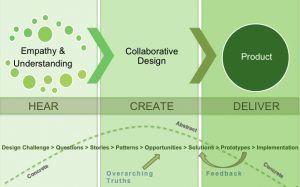Human Centered Design Trainings
Human Centered Design Trainings for Teams
One day training for teams solving complex problems with various stakeholders
Summary: Design Thinking is a method of problem solving that uses empathy for understanding the context of a problem, creativity in identifying insights and possible solutions, and rationality in analyzing and planning various solutions.
In this one-day training we focus on the HEAR and CREATE portion of the Human Centered Design toolkit, and leave the DELIVER portion for our clients to explore on their own.
A BRIEF OVERVIEW OF THE PROCESS
The HCD process uses unique tools to capture the users’ perspective. HCD engages direct participation by constituents early and often in the design cycle. Also, the process goes deep rather than broad. Instead of looking at averages, which often miss a large portion of the users needs, we look at extremes.
During the “HEAR” portion of the training, the participants use many qualitative methods to reach the goal of understanding their constituents point of view and reasoning. Through the process the participants come away with a deeper understanding of the needs of their constituents, as well as the constraints and barriers to the design challenge.
During the CREATE phase, participants translate insights about the reality of today into a set of opportunities for the future. The team then brainstorm solutions for those opportunities and rapidly made a few of them tangible through prototyping.
At the end of the CREATE phase participants present prototypes and gather feedback from their constituency. The intent of gathering feedback is to refine the solutions not to prove that they were perfect. The best feedback is that which makes you rethink and redesign.
Through the first stages of this process participants assessed solutions through the desirability lens only, ignoring the lens of feasibility, which is the focus of the DELIVER phase. Here is where they will develop a financial model, identify capabilities, plan for growth, create an implementation time line, test with mini pilot projects, and finally evaluate the effectiveness of their project. Another goal of the DELIVER phase is to create a plan for on-going learning and iteration so that your solutions can improve and adapt to changing situations.

